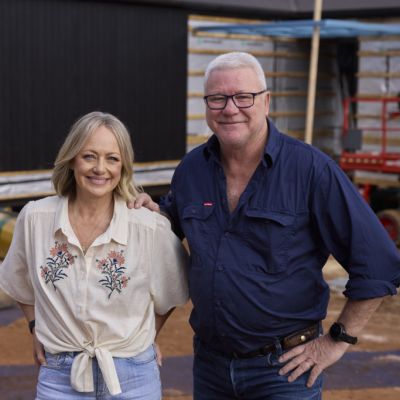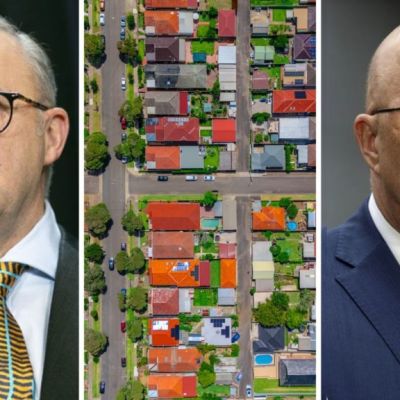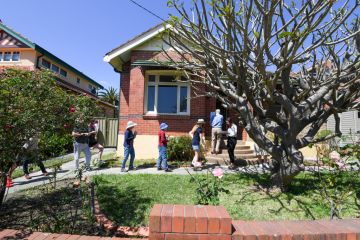‘Huge tailwind’: When you should have bought a house
Property buyers could have made a 70 per cent capital gain in five years if they bought at the start of last decade’s boom in Sydney or Melbourne but would have been unable to repeat that level of growth since.
But if they had purchased in Brisbane or Perth five years ago, they would have been able to make a similar gain.
 The best returns over the past five years were not from the typical home in Sydney or Melbourne.Joe Armao
The best returns over the past five years were not from the typical home in Sydney or Melbourne.Joe ArmaoThe rolling five-year gains for property buyers have varied widely since last decade’s boom, new analysis shows. Buyers in some years would have made modest gains or less, while others would have caught the tailwind of falling interest rates.
Experts warn that boom times can be followed by a period where a market is seen as relatively unaffordable, leaving prices to stagnate, while demand increases in more affordable markets. Buyers are often counselled to pick the best property rather than trying to time the market.
Falling interest rates during the early 2010s prompted an east coast property boom. A buyer who purchased the median house in Sydney in 2012 or early 2013 would have made north of 60 per cent over the next five years, peaking at 85.8 per cent in the half-decade to June 2017, Domain figures show.
Melbourne buyers’ gains over the same period would have topped out at 69.2 per cent in the five years to March 2018, but buyers throughout 2012 would have gained close to 60 per cent-plus by 2017.
By contrast, Perth’s median house price was little changed over the same period, and Brisbane’s median house price rose less than 30 per cent.
The growth reversed since the pandemic began.
Sydney’s median house price has risen 45.7 per cent in the five years since March 2020.
Melbourne recorded a smaller increase in that time of 13.8 per cent.
Prices soared in the once more affordable capitals, and Brisbane rose 71.5 per cent in the past five years to March 2025 while Perth gained 73.2 per cent.
AMP chief economist Shane Oliver attributed the growth cycle until 2018 to low interest rates, which fell during late 2011, 2012 and hit what was then an ultra-low 2.5 per cent in 2013. They fell further in 2015-16.
“So 2013 was a reasonably good starting point for property buyers because it covered a period through which interest rates were going sideways or down,” he said.
“There was a huge tailwind behind the property market of falling interest rates that helped push property prices up during that period.”
He noted the two largest city markets have since taken a backseat relative to the growth in Brisbane, Adelaide and Perth which were once seen as better value.
“Whichever way you cut it, they’re all poorly affordable relative to 20 to 30 years ago,” he said.
“History tells us this is all mean reverting, it’s swings and roundabouts. Just because Adelaide, Brisbane and Perth have been doing well doesn’t mean it’s going to continue. I don’t think it will.”
SQM Research managing director Louis Christopher said housing prices in Perth, and to a lesser extent Brisbane, had been affected by commodity markets. Perth had a housing boom for about a decade to 2012 in line with the commodity boom, he said.
The east coast was more sensitive to low interest rates combined with relatively strong population growth during the 2010s until a bank crackdown on lending and uncertainty over potential curbs on negative gearing tax deductions in the 2019 election.
More recently, he said housing supply and movement of residents had affected prices.
“Melbourne historically has been better at providing new supply to the market than Sydney has been,” he said.
“Sydney is kind of hamstrung in a way in terms of how the city is mapped out. Melbourne has more land to build on in its outer suburb fringes and there is more of a building opportunity in inner-city Melbourne.”
He said Victoria’s increase in land tax on second homes last year may have affected the housing market.
But a pick-up in iron ore prices combined with interest rate cuts, a building shortage and interstate migration pushed prices up in Perth recently, he said.
Anthony Landahl, managing director at mortgage broker Equilibria Finance in Sydney, has been fielding demand from property investors looking interstate or in regional NSW.
His buyers are looking for capital growth and rental returns. Some come to him with a location in mind, others are guided by their budget.
“Because Sydney’s median house price is so much higher than everybody else’s that has made investing prohibitive to a lot of people,” he said.
“We’ve had some home buyers who, instead of buying their first home, they buy investment property, and they are looking beyond Sydney.”
We recommend
We thought you might like
States
Capital Cities
Capital Cities - Rentals
Popular Areas
Allhomes
More










